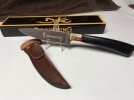I am sorry Dan if this has been asked before, but why does your knife have a split in the blade? Is that just cosmetic, or is it actually two pieces welded together?
It's ground in two directions, my guess because they want to grind near the button but not into it. My larger Juca has it too.
Though I'm not Dan.
Hi Jeff, I think is just cosmetic.
As Jer pointed out the blade is ground in two directions.
Some of the old criollo knives were done this way and it sort of became a tradition.
There is some speculation as to the reason behind this "differential polishing" exhibited on some traditional gaucho knives.
Some people theorize that the blade had two different levels of harness. A tougher ( not as hard ) portion of the blade and a harder portion with more edge retention ( but less tough ). The contrast in the polishing delineante the two areas.
I think this is mostly a myth.
I consulted an expert and author on criollo knives from Argentina an he does not believe the above to be the case at all.
He believes it was simply because the grinding wheels were not large enough so they did it in two steps.
Also as Jer suggested it makes sense that they would not want to grind into the bolster ( button ).
Here is a couple of old gaucho knives where this "differential polishing" can be seen
My "Pampa", made in Tandil Buenos Aires dated 1963

























